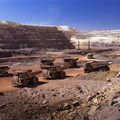Omnia's BME division has recently tackled a challenge at a South African iron ore mine, where a reduction in blasting efficiency prompted them to investigate a new mechanism for bulk emulsion decomposition. Their groundbreaking findings, published in the International Society for Explosives Engineers' Journal of Explosives Engineering, have implications for the global mining industry.

Decomposed emulsion and water. Source: BME
The investigation, led by BME specialists Scott Scovira, Dirk Voogt, and Quentin Steyl, began when the mine encountered unexpected issues with their bulk emulsion explosives.
The team's extensive testing ruled out common culprits like reactive soil or acidic water, leading them to a surprising discovery: the presence of potential acidic sulphate soil (PASS).
"A deeper investigation into the ground mineralisation revealed the presence of PASS, which is a new mechanism for bulk emulsion breakdown," the specialists explained.
Before this, PASS had never been observed in over 50 years of emulsion usage and had not been previously described in the context of bulk emulsions.
Innovative solutions
The team's research revealed that PASS could become an acid sulphate soil in the presence of a strong oxidiser, leading to the breakdown of the emulsion.
To address this, they explored the use of an emulsified gassing agent (EGA), which, due to its high viscosity, reduced contact between the gassing agent and the PASS.
"These modifications to the bulk explosives system have provided a window of protection for the straight bulk emulsion against these site ground conditions," they said.
They have also enhanced resistance to product degradation by the action of dynamic water present at the mine site.
The implementation of EGA resulted in important performance improvements, including increased detonation velocity.
New avenues
The team have not only solved the immediate challenge at the mine but also opened new avenues for research and development in the field of explosives engineering.

BME Global Manager Blasting Science Scott Scovira
“As PASS has been only recently discovered as an emulsion decomposition mechanism, we expect there will be considerable learnings achieved in the future,” they concluded.
“The focus will be on continuously improving the inhibition process against sulphate ground types – through chemical formulation and mechanical manipulation.”
“We trust that our investigation and solutions will add valuable insights to blasting professionals and the global explosives engineering community.”















































